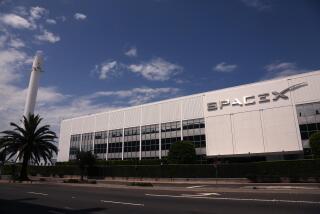VW California: Dreams do come true -- in Europe
THE BLACK FOREST, GERMANY — I would like many things. I would like a large four-bedroom ranch home to fall on Jon and Kate. I would like my life to be more like Bollywood. I wish my hair could talk.
These things are not going to happen. Indeed, I could spend this column and the next listing all the things I desire but am not going to get: a 1-meter telescope; a poodle with a knowledge of fine wine. Somebody stop me.
In a column a few weeks ago I rolled a grenade under the epically chintzy VW Routan, and whilst so doing bemoaned the fact that VW -- the company whose heritage of van-making includes the beloved Westfalia camper van -- did not offer a modern version of the Westy, preferably with a high-output diesel engine and all-wheel drive. Au contraire, readers wrote back. VW offers precisely that vehicle, in Europe.
I happened to be on the Continent this week anyway and so arranged to borrow the vehicle you see here, the VW California, which is, maddeningly enough, not offered in California or anywhere else in the U.S. (more on that in a moment). This particular model was equipped with a gleaming, beautifully made custom bike rack. That makes the vehicle a California Biker.
Wishes do come true.
Did you go to Humboldt State? Did you vote for McGovern twice (once as a write-in candidate)? Did you stop following the Grateful Dead because they became too corporate? Brace yourself. This is the Westy of your dreams: a state-of-the-art camper van with a gas stove, running water, an electrically deployed pop top, a fold-down double bed, rotating front captain’s chairs and a staggering number of reading lights, climate outlets, cabinets, storage bins and convenience features, and all of it executed with the kind of aerospace precision one might associate with Piaggio corporate jets.
Now, obviously this isn’t your beloved split-window Westy, in which I’m sure you sired many a love child you later named Summer and Prometheus. Where once there were gingham curtains, the neo-Westy has tinted and double-glazed windows and roll-out privacy screens that deploy from the window frames. Where once there was painfully crude lacquered pine cabinetry, there’s laser-cut blond wood like something that retails at Design Within Reach. The old Westy had a roll-out canvas awning, the quality of which was unknown outside certain Bedouin tribes. The California has a high-tech laminated awning that cranks out on lever arms.
And the signature move for the Westy -- the pop top -- is here a push-button electro-hydraulic affair, as opposed to the toiling, hand-crank job of decades past. The button to open and close the top -- “offnet” and “schliessen” in the van’s native German -- is located on a central overhead control panel that also monitors camper systems such as battery levels, 230-volt connection status, “cool box” status and fresh- and gray-water levels. Nifty.
It would take too long to describe the thousand clever details of the California, such as the way the front seats rotate to face the cabin or the way the table hides away in a sliver of space beside the couch. Built into the rear hatch is a canvas compartment that neatly holds two folding chairs. It takes roughly three minutes to go from rocking down the highway to a fully established base camp, with the top up, the awning deployed and the chairs set out. Now where’s that Frisbee?
There is one more huge difference between this vehicle and the old Westy, which moved like a heavily medicated Galapagos tortoise. The California actually goes pretty quick, thanks to a heroic intercooled and turbocharged five-cylinder diesel engine, good for 174 horsepower at 3,500 rpm and a Freightliner-worthy 295 pound-feet of torque at 2,000 rpm. Backed up by a six-speed manual transmission, our California was easily in the 10-second range in accelerating to 60 and could effortlessly cruise at Autobahn speeds. The diesel also allows the big van to get 30 mpg. Amazing.
I spent the day bombing around the Black Forest in the California and, while I left no sport-bike riders crying in their helmets, I must say, the California acquitted itself well. In a fast corner it has got body lean like a Spanish galleon, but it’s manageable. Braking is secure. Steering is direct and communicative. And I’m not complaining, but VW chose to shoe this Percheron with the raciest horseshoes in the world, Dunlop SP9000 radials. What’s that about?
On the downside -- if this is a downside -- the thing sounded positively agricultural at idle. Also, all this content comes at a cost in the not-trivial curb weight of 6,600 pounds. If you listen closely you can hear quaint wooden bridges scream as it goes over.
The overarching impression is one of exceptional, out-of-the-park quality. Here, a little back story is useful. Westfalia was, in fact, a company that did camper conversions for lots of brands, most famously for VW. However, in 1999, Mercedes-Benz bought the company and ended the VW collaboration. VW brought its conversion business in-house. What we have here is a factory-spec conversion, built to Wolfsburg’s standards pretty much by hand and, I’m guessing, probably at a bit of a loss, only to hold up a tradition.
Why not sell the California is the U.S.? Why do we get only the rough-trade Routan? One rather large word: homologation. It would cost far too much to make the diesel California legal in the States, considering the small number of vehicles the company could actually sell at a price exceeding $50,000.
On the other hand, maybe not. What if VW of America heard a loud outcry for the California? What if people started sending deposits? In these more constrained times, the California seems like the perfect vehicle for people downsizing from the awful hugeness of traditional RVing.
Make a wish. Wake up the genie. But be careful that when you ask for “California Biker,” you don’t get Sonny Barger.
--
--
BEGIN TEXT OF INFOBOX
2010 VW California Biker
Price as tested: $60,000
Powertrain: Intercooled and turbocharged five-cylinder diesel engine; six-speed manual transmission; all-wheel drive
Horsepower: 174 at 3,500 rpm
Torque: 295 pound-feet at 2,000 rpm
Curb weight: 6,600 pounds
Wheelbase: 118.1 inches
Overall length: 192.5 inches
0-60 mph: 10 seconds
EPA fuel economy: 30 miles per gallon city/highway combined
Final thoughts: Camper van Beethoven
Source: Volkswagen
More to Read
Sign up for The Wild
We’ll help you find the best places to hike, bike and run, as well as the perfect silent spots for meditation and yoga.
You may occasionally receive promotional content from the Los Angeles Times.






